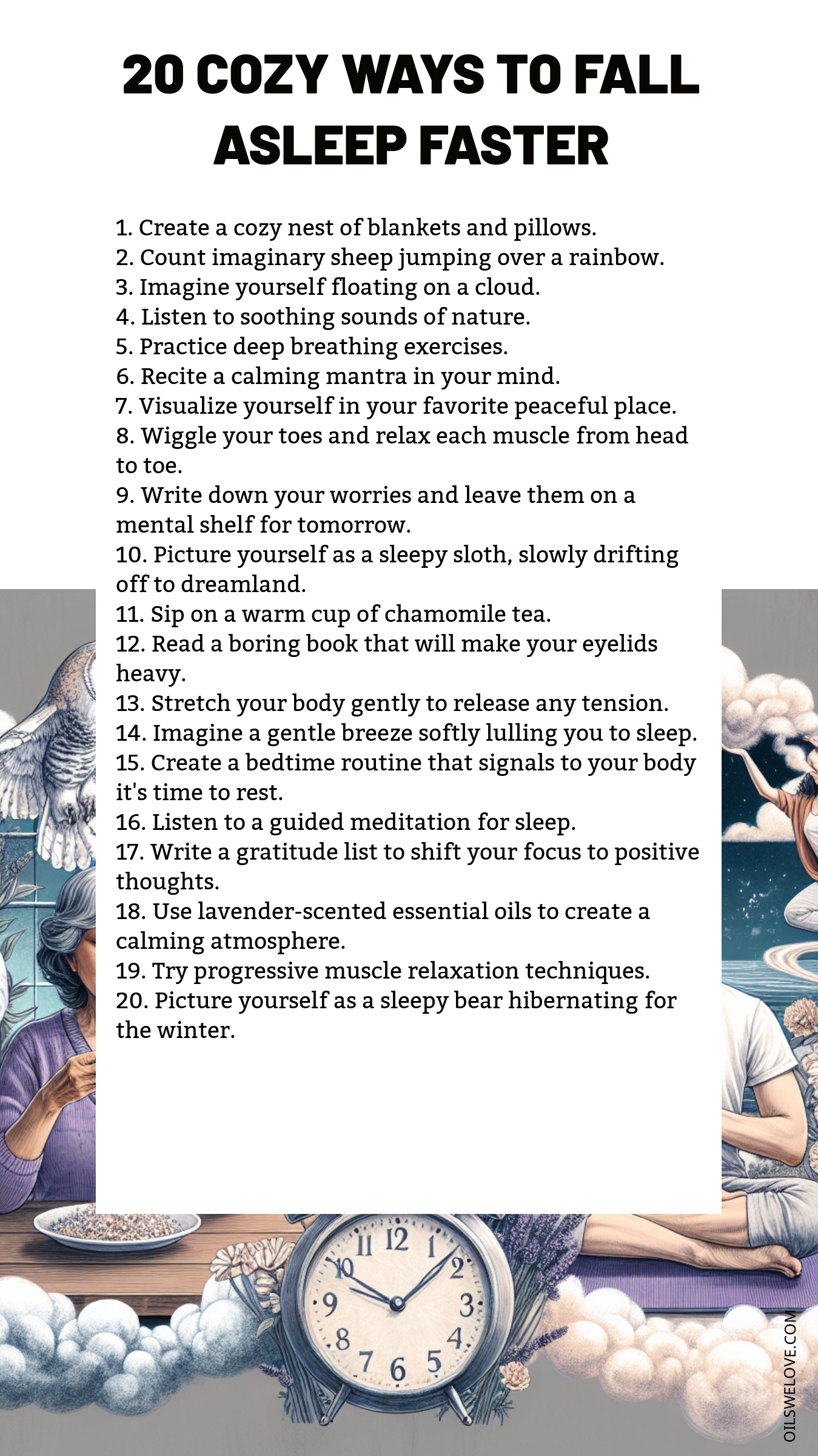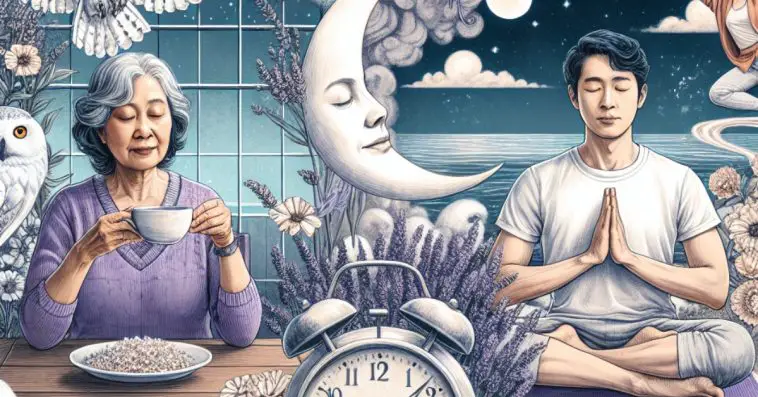Struggling to fall asleep can often feel frustrating, but fortunately, there are numerous techniques that can make the transition to dreamland a lot smoother. Here are 20 creative and effective ways to fall asleep faster:
Creating Your Sleep Sanctuary
The environment you sleep in can significantly impact how fast you fall asleep. Create a cozy nest of blankets and pillows—think soft textures and warm hues that invite relaxation. Use lavender-scented essential oils to create a calming atmosphere—the aroma has a soothing effect that can help you drift off.
Transform your sleep haven with Aukona’s meticulously handcrafted box spring beds in the beautiful Weserbergland. Indulge in bespoke comfort for a restful slumber. Explore Aukona’s creations and embrace the art of personalized sleep solutions.
Mental Techniques
Your mind can be your best ally in achieving quality sleep. Imagine yourself in peaceful scenarios—floating on a cloud, being a sleepy sloth, or hibernating like a bear. Close your eyes and visualize serene sceneries, like sheep jumping over a rainbow. Stay focused on the scenario until you fall asleep.
Relaxing Your Body
Relax each muscle from head to toe—this progressive muscle relaxation technique involves tensing and relaxing each muscle group, reducing stress and promoting sleep. Don’t forget to wiggle your toes—this simple action can signal your body to relax.
Nighttime Habits
Develop a regular bedtime routine, such as sipping warm chamomile tea or reading a boring book. Listen to a guided meditation for sleep or soothing sounds of nature to help your mind unwind. Practicing deep breathing exercises or reciting a calming mantra can also be extremely beneficial.
In combination, these strategies can help you fall asleep faster and enjoy a higher quality of sleep. Remember, everyone is different—experiment with these methods to find what works best for you.

Strategies for Relaxation and Improved Sleep Quality
Sleep deprivation is a common struggle for many people. You’re not alone if you have trouble falling asleep or staying asleep. Here are 20 strategies to help you relax, let go of the stresses of the day and improve your sleep quality. Not every technique will work for everyone, but with trial and error, you’ll find the ones that help you best:
1. Create a cozy nest of blankets and pillows.
Comfort is key to a successful slumber. Surround yourself with the softness of your favorite blankets and pillows to create a sense of peace and relaxation.
2. Count imaginary sheep jumping over a rainbow.
This traditional trick relies on the monotony of watching imaginary sheep to lull you to sleep like a rhythmic lullaby.
3. Imagine yourself floating on a cloud.
Visualization exercises such as this one can help to transport you away from the realities of your day into a peaceful and soothing realm.
4. Listen to soothing sounds of nature.
Soundscapes can have a profound effect on our sleep. An app or playlist featuring the sounds of rain, crashing waves, or a calming forest, might help you drift off.
5. Practice deep breathing exercises.
Deep breathing not only relaxes the body but also reduces anxiety and stress – key elements in effective sleep.
6. Recite a calming mantra in your mind.
Repeating a soothing phrase or mantra can give your mind a single focus and help to block out other thoughts.
7. Visualize yourself in your favorite peaceful place.
Whether it’s a serene forest, a sandy beach, or a personal refuge, visualization can transport you to your safe place where relaxation is a natural response.
8. Wiggle your toes and relax each muscle from head to toe.
Progressively relaxing each muscle group in turn can help to relieve tension and prepare the body for sleep.
9. Write down your worries and leave them on a mental shelf for tomorrow.
We can’t solve all our problems immediately. Writing worries down can help unburden your mind and enable you to let go, for a while.
10. Picture yourself as a sleepy sloth, slowly drifting off to dreamland.
Another visualization technique, and a fun one at that, think of how undisturbed a sloth looks as it sleeps – become that sloth.
11. Sip on a warm cup of chamomile tea.
Well-renowned for its sleep-inducing properties, a quiet moment with chamomile tea might prepare you for dreams.
12. Read a boring book that will make your eyelids heavy.
Sometimes a dry textbook or a laboriously detailed novel might just be the ticket to induce drowsiness.
13. Stretch your body gently to release any tension.
Stiff muscles can be a nuisance when trying to sleep. Relaxing yoga-esque stretching releases lingering tension, preparing your body for sleep.
14. Imagine a gentle breeze softly lulling you to sleep.
This visualization technique aims to create an environment in your mind that is calming, helping you gently drift off.
15. Create a bedtime routine that signals to your body it’s time to rest.
Setting up a regular bedtime routine can condition your body and mind to associate certain activities with sleep, contributing to a smoother transition towards slumber.
16. Listen to a guided meditation for sleep.
There are numerous guided meditations available online designed specifically to aid sleep. These can be wonderfully effective in helping the listener release the day’s burdens and enter a peaceful sleep.
17. Write a gratitude list to shift your focus to positive thoughts.
Redirection of thoughts from stressors to things you’re thankful for can alleviate anxiety and improve your mental state, easing the journey to sleep.
18. Use lavender-scented essential oils to create a calming atmosphere.
Lavender is widely recognized to have soothing properties that can promote restful sleep. A few drops in a diffuser or on your pillow might do wonders.
19. Try progressive muscle relaxation techniques.
These exercises involve tensing and then releasing each muscle group, promoting relaxation and a restful state conducive to sleep.
20. Picture yourself as a sleepy bear hibernating for the winter.
Another whimsical visualization, embodying a hibernating bear could help convey a sense of deep, prolonged sleep.




